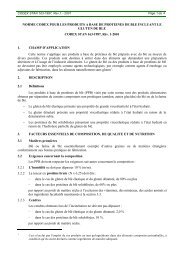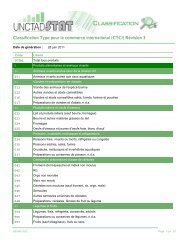issues and constraints related to the development of cashew nuts ...
issues and constraints related to the development of cashew nuts ...
issues and constraints related to the development of cashew nuts ...
You also want an ePaper? Increase the reach of your titles
YUMPU automatically turns print PDFs into web optimized ePapers that Google loves.
8This issue needs <strong>the</strong>refore clarification <strong>and</strong> fur<strong>the</strong>r work. Two possibilities could explain thisapparent contradiction:o Due <strong>to</strong> differing environmental conditions in o<strong>the</strong>r years, anthracnose has in fact beenmore <strong>of</strong> a problem in <strong>the</strong> past, <strong>and</strong> could be in <strong>the</strong> future;o Field workers have confused o<strong>the</strong>r types <strong>of</strong> damage for anthracnose, leading <strong>to</strong> misidentification(during <strong>the</strong> survey, o<strong>the</strong>r types <strong>of</strong> insect damage were attributed <strong>to</strong>anthracnose in a number <strong>of</strong> occasions).A certain type <strong>of</strong> disease found <strong>to</strong> be quite prevalent in <strong>the</strong> Dabola/Kankan area <strong>of</strong> Guinea <strong>and</strong>around Odienne, in Côte d’Ivoire, fur<strong>the</strong>r confused <strong>the</strong> situation. This disease that was foundonly on leaves, was initially thought <strong>to</strong> be <strong>the</strong> rust coloured algae Cephaleuros virescens atvarious stages <strong>of</strong> <strong>development</strong>. Leaf samples with this disease were sent <strong>to</strong> <strong>the</strong> InternationalMycological Institute (IMI) in UK, which identified Colle<strong>to</strong>trichum gleosporioides (Glomerellacingulata) <strong>and</strong> Phomopsis anacardii.There are a number <strong>of</strong> possible explanations:o Colle<strong>to</strong>trichum gleosporioides, which is common in <strong>the</strong> soil <strong>and</strong> on o<strong>the</strong>r plants waspresent on <strong>the</strong> leaf, but was not active or pathogenic <strong>to</strong> <strong>the</strong> <strong>cashew</strong> leaf (i.e.accidentally present)o The genus Glomerella cingulata contains saprophytic strains, <strong>and</strong> hence could havebeen present as a secondary infection, i.e. it was feeding <strong>of</strong>f dead tissue caused by aprevious pathogeno Pathogenic Colle<strong>to</strong>trichum gleosporioides could have been present before, but due <strong>to</strong>unfavourable wea<strong>the</strong>r conditions it did not develop fully.More work in this area is required.In East Africa, where powdery mildew disease is <strong>the</strong> main disease constraint, <strong>the</strong>re is a very lowincidence <strong>of</strong> anthracnose. It only affects a very small percentage <strong>of</strong> panicles on a very smallnumber <strong>of</strong> trees, hence, very little work has been undertaken on <strong>the</strong> problem <strong>the</strong>re. Since <strong>the</strong>introduction <strong>of</strong> Brazilian dwarfs, anthracnose has become a more noticeable problem, but it isstill mainly confined <strong>to</strong> dwarf trees (e.g. in Mozambique at Monapo, I<strong>to</strong>culo <strong>and</strong> recently atNassuruma). The situation at I<strong>to</strong>culo was so bad, that most <strong>of</strong> <strong>the</strong> dwarf trees were cut down inan attempt <strong>to</strong> control <strong>the</strong> disease. However, <strong>the</strong> fact that <strong>the</strong> disease had spread <strong>to</strong> local tall treeswas more worrying.It can be assumed that, since common tall trees in Brazil are very susceptible <strong>to</strong> anthracnose, talltrees in both West <strong>and</strong> East Africa will be similarly susceptible, since <strong>the</strong> African trees originatedfrom Brazil many years ago. The fact that <strong>the</strong> disease has not become established in East <strong>and</strong>West Africa could be attributed <strong>to</strong> environmental, cultural or o<strong>the</strong>r reasons. However, strictquarantine regulations must be maintained or instigated, if <strong>the</strong>y are not already in place, whenplanting material is imported, especially from outside <strong>the</strong> region.Cephaleuros virescens (red or rust coloured algae)This algae was identified by IMI from <strong>cashew</strong> leaves collected from <strong>the</strong> Accra region <strong>of</strong> Ghana,during a visit in May 2000, <strong>and</strong> seen at various locations during <strong>the</strong> survey. This algae is acommon parasite <strong>of</strong> evergreen perennial crops <strong>and</strong> is not considered <strong>to</strong> be a constraint <strong>to</strong> <strong>cashew</strong>production.



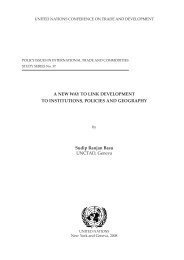
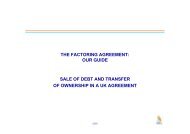
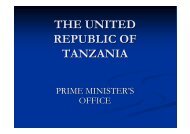
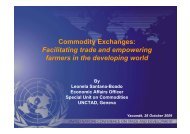
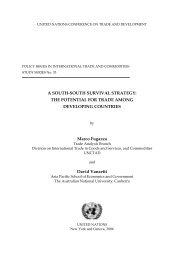
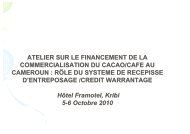
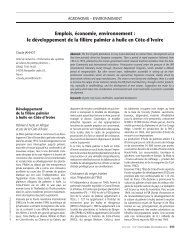
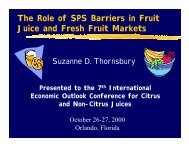

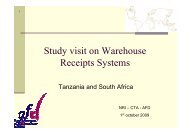
![Warehouse Receipt Systems: Legal Issues [PDF]](https://img.yumpu.com/43979338/1/190x134/warehouse-receipt-systems-legal-issues-pdf.jpg?quality=85)
